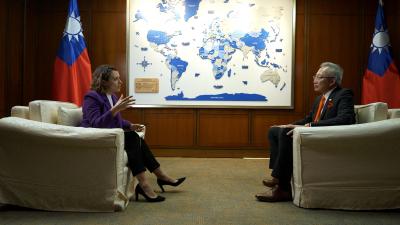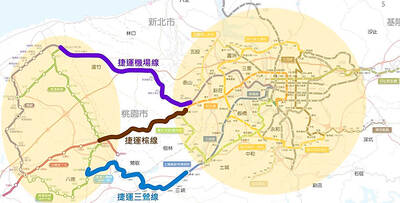Every year, a ceremony takes place in the mechanical engineering department at Tatung University. Professor Lai Kuang-che (賴光哲) leads students in taking an oath: “I sincerely swear to make it my life’s mission to put all the knowledge learned from my four years of college to good use. For myself, my dreams, my satisfaction and my family, I swear that from today onward I am a creator and an inventor.”
The ceremony usually ends with Lai demonstrating the theory of friction by making fire, which symbolizes the start of class and also gives students the chance to reflect on humanity’s most ancient innovation.
According to Lai, the department espouses creation and in the 25 years that he has taught at the university, Lai has spared no effort in trying to encourage his students to become inventors by helping them develop basic engineering skills, techniques and a sense of aesthetics.

Photo: Liu Hsin-de, Taipei Times
Traditional educational methods prioritize theory over practice, but good teaching requires more than just chalk and a blackboard, and this is especially true when the subject being taught is mechanical engineering, Lai said, adding that engineering students must work with their hands to understand the theories they are learning.
Gesticulating enthusiastically as he walks around the classroom wearing his signature overalls, Lai lectures as if he is preaching, saying: “Only humans solve problems by creating things.”
To teach the creative process, Lai has his students start with a basic task: creating a paper airplane.
“You start by drawing a design, then making the plane,” Lai said, adding that if the airplane does not fly well or at all, student know that their design needs more work and they can experiment with changes to fix the problems.
An inventor must first have the capacity to create something, before solidifying his or her technique and refining their sense of aesthetics, Lai said.
It was this ethos that inspired the department’s famed annual paper airplane competition, in which more than 100 freshmen compete to see who can design a plane that can fly for longer than nine seconds.
Lai said that a student once designed a plane that flew for 13 seconds, adding that winning the contest was an illuminating experience for the student that “took him to another level in his life.”
Lai’s primary goal is to cultivate the spark of creativity he believes is present in every student’s mind. To achieve that end, he asked the university to set up a factory that mechanical engineering students can use to create anything they like.
Some of his graduate students used the faciltiy to invent a mechanical robot that can move around without batteries by using screws, iron bars and wooden blocks instead, Lai said, adding that simple adjustments to the placement of the screw caps on the robot’s head and the curvature of the wooden blocks forming its legs can determine the size of its steps.
The robot not only showed off the students’ creativity, but proved that they had understood the basic theory of mechanics, Lai said.
Lai also uses landmark innovations, such as the steam engine, to inspire his classes.
Lai has established a camp that his students are required to attend during summer or winter vacation where they learn how to build a steam engine from scratch.
Lai said the camp was aimed at giving students a feel of the invention that had brought about the dawn of the modern age. He joked that the camp was a rite of initiation that “transformed students from non-entities into true men and women,” because it was transforming them into engineers.
Due to retire in two years, Lai hopes to produce more talented personnel for the field of mechanical engineering by training students early on in vocational high schools.
“If there were no inventors, the human race would not be where it is right now — the camera, the book in which you write, the pen in my hands, these are all inventions that solve problems that society has encountered,” Lai said.
As the living embodiment of the phrase “Joy in creation” (造物最樂) that hangs in the hall of the department’s research building, Lai derives joy from creating, whether what he is producing is a mechanical invention or talented graduates.

“China is preparing to invade Taiwan,” Deputy Minister of Foreign Affairs Francois Wu (吳志中) said in an exclusive interview with British media channel Sky News for a special report titled, “Is Taiwan ready for a Chinese invasion?” the Ministry of Foreign Affairs said today in a statement. The 25-minute-long special report by Helen Ann-Smith released yesterday saw Sky News travel to Penghu, Taoyuan and Taipei to discuss the possibility of a Chinese invasion and how Taiwan is preparing for an attack. The film observed emergency response drills, interviewed baseball fans at the Taipei Dome on their views of US President

The Central Weather Administration (CWA) today issued a "tsunami watch" alert after a magnitude 8.7 earthquake struck off the Kamchatka Peninsula in northeastern Russia earlier in the morning. The quake struck off the east coast of the Kamchatka Peninsula at 7:25am (Taiwan time) at a depth of about 19km, the CWA said, citing figures from the Pacific Tsunami Warning Center. The CWA's Seismological Center said preliminary assessments indicate that a tsunami could reach Taiwan's coastal areas by 1:18pm today. The CWA urged residents along the coast to stay alert and take necessary precautions as waves as high as 1m could hit the southeastern

ECONOMIC BENEFITS: The imports from Belize would replace those from Honduras, whose shrimp exports have dropped 67 percent since cutting ties in 2023 Maintaining ties with Taiwan has economic benefits, Ministry of Foreign Affairs officials said yesterday, citing the approval of frozen whiteleg shrimp imports from Belize by the Food and Drug Administration (FDA) as an example. The FDA on Wednesday approved the tariff-free imports from Belize after the whiteleg shrimp passed the Systematic Inspection of Imported Food, which would continue to boost mutual trade, the ministry said. Taiwan’s annual consumption of whiteleg shrimps stands at 30,000 tonnes, far exceeding domestic production, the ministry said. Taiwan used to fill the gap by importing shrimps from Honduras, but purchases slumped after Tegucigalpa severed diplomatic ties with Taiwan

The Executive Yuan yesterday approved a southwestern extension of the Sanying MRT Line from New Taipei to Bade District (八德) in Taoyuan, with a goal of starting construction by late 2026. The 4.03-kilometer extension, featuring three new stations, will run from the current terminus at Yingtao Fude Station (LB12) in New Taipei City to Dannan Station (LB14), where it will connect with Taoyuan’s Green Line, New Taipei City Metro Corp said in a statement. This extension will follow the completion of core Sanying Line, a 14.29-kilometer medium-capacity system linking Tucheng (土城), Sansia (三峽)